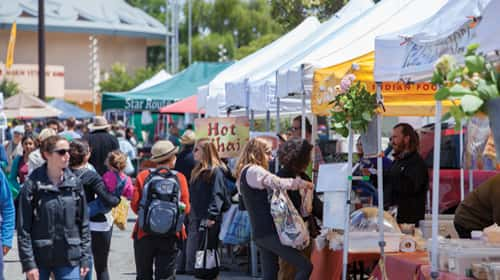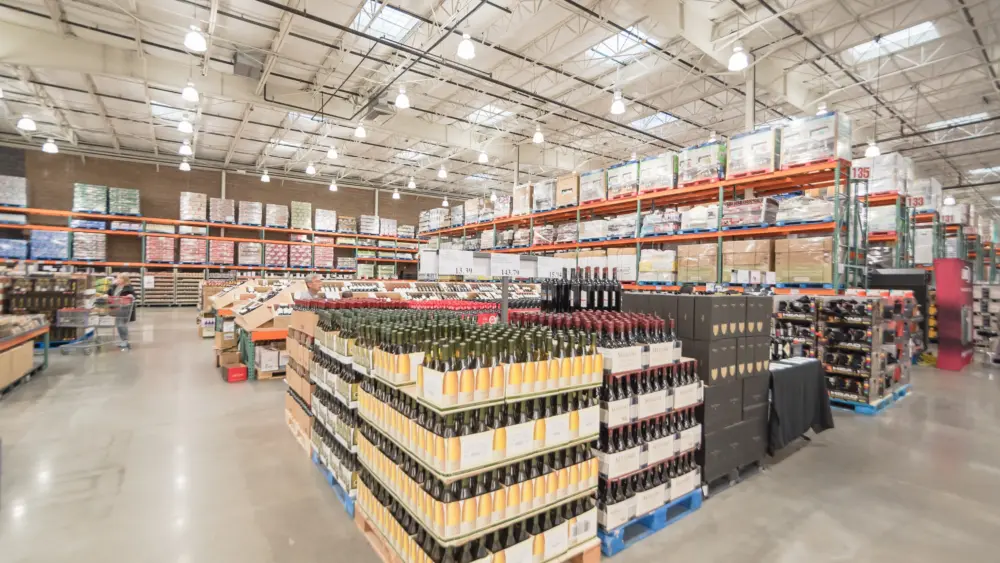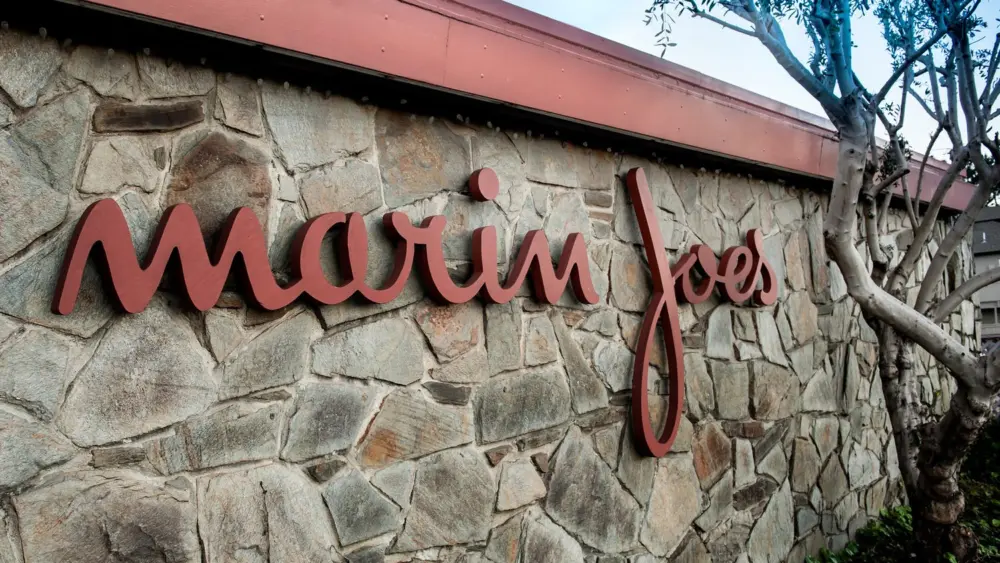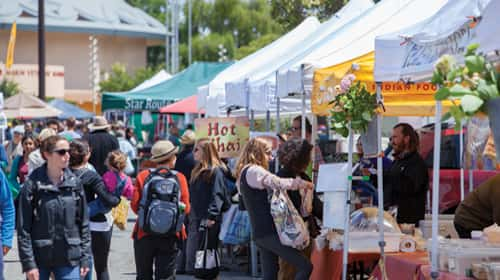 On a cloudy Sunday, the Marin Civic Center Farmers Market is jammed by rows of booths, with farmers and ranchers side by side. Brewers of the bean are doing a conspicuous business as couples walking hand-in- hand and chefs shopping for inspiration and fresh ingredients hold steaming cups, as if Saturday night and Sunday morning landed closer together than the clock suggests. Food trucks ring part of the market, locked in mortal combat for the hearts and taste buds of the 10,000 shoppers, though the wheeled food wagons are far outnumbered by designer strollers with dads in baseball caps and moms in yoga pants.
On a cloudy Sunday, the Marin Civic Center Farmers Market is jammed by rows of booths, with farmers and ranchers side by side. Brewers of the bean are doing a conspicuous business as couples walking hand-in- hand and chefs shopping for inspiration and fresh ingredients hold steaming cups, as if Saturday night and Sunday morning landed closer together than the clock suggests. Food trucks ring part of the market, locked in mortal combat for the hearts and taste buds of the 10,000 shoppers, though the wheeled food wagons are far outnumbered by designer strollers with dads in baseball caps and moms in yoga pants.
Those stalking organic greens and nitrate-free sausage are strolling the upper parking lot at the center designed by Frank Lloyd Wright, the home of this market since 1983. On Sundays, the market magically pops up out of parking spaces, as farmers, ranchers and Agricultural Institute of Marin (AIM) staff arrive as the rooster crows to set up shop. Booths emerge from the ether and the back of pickup trucks, as fresh produce from as far away as the Central Valley and as close as West Marin lands on folding tables. On Thursday the market’s home is the Marin Center parking lot just off the Avenue of the Flags. And at the end of the market, it vanishes like the 49ers Super Bowl hopes in November.
But in recent months, the Thursday market moved to the Northgate Center shopping mall as the county of Marin has been busy creating a roundabout and doing street work along Civic Center Drive. While the streetscape will certainly serve new SMART train passengers once the commuter rail makes it long, long, long-awaited debut, the $2 million facelift is also setting the table for AIM and its $24 million “Public Market Hall and Canopy,” a permanent home for the Marin landmark—the third largest farmers market in the state.
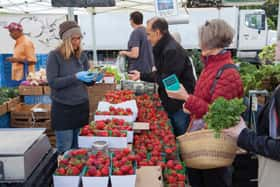 AIM is a non-profit 501(c)(3) entity that operates seven farmer’s markets in the Bay Area. Besides the two at the Civic Center, the organization also hosts two markets in San Francisco: one on Clement Street, the other at the Stonestown shopping center off 19th Avenue. There is another market at Grand Lake in Oakland, one in Hayward and another at the Newark Mall. AIM has about 25 employees.
AIM is a non-profit 501(c)(3) entity that operates seven farmer’s markets in the Bay Area. Besides the two at the Civic Center, the organization also hosts two markets in San Francisco: one on Clement Street, the other at the Stonestown shopping center off 19th Avenue. There is another market at Grand Lake in Oakland, one in Hayward and another at the Newark Mall. AIM has about 25 employees.
The new project will sit on plot of land that for years was vacant, except at Christmas when a tree emporium popped up, downhill from the county jail and hard by the county motor pool. It’s also a stone’s throw from the SMART train stop, and when I say stone’s throw, you don’t have to have a wing like noted motorcycle aficionado Madison Bumgarner to get there. It’s bordered by Civic Center Drive and Peter Behr Drive.
The three-building complex will have 30,000 square feet of space that will bustle with a wealth of activity. It will include a butcher shop, a store with dairy products, a bakery and a restaurant with a demonstration kitchen. It will have covered areas for 90 vendors, as well as space for another 150 vendors, a café, conference area and greenhouse. The complex will also include offices for AIM, as well as the Marin Farm Bureau, the Marin Agriculture Land Trust, the Resource Conservation District and the UC Ag Cooperative.
It will be designed by Backen, Gilliam & Kroeger Architects, which has hung shingles in both Sausalito and St. Helena. It is something of a specialty shop and its credits include the new line of Restoration Hardware stores, Robert Redford’s Sundance Institute in Utah and the Performing Arts Center in St. Helena.
And while Howard Backen’s design is certainly a selling point, for AIM it’s just one of many ingredients in a recipe to tempt foodies and investors. AIM has produced an investor’s deck on its website that is equal parts human touch and business plan. Snapshots with captions in the middle of them read “Farms, Food, Family, Health and Land” are the deck’s cover.
AIM knows that the kitchen is both the real and the figurative heart of the American home, the place which we gravitate to feed not just our bodies but our souls as well. The fact is, no matter how large the house or how great the view, at some point the party ends up in the kitchen—if for no other reason than that’s where everything is, including the ice.
So the new market is being pitched as a gathering place, somewhere that we all can go to seek not just spectacular Brussels sprouts or free range turkey, but camaraderie in a world that spins too quickly casting us too far from each other.
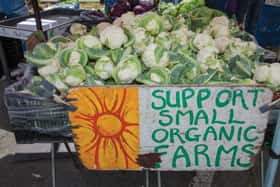 “Marin, we love our food,” reads the header for one page of the investor deck. “We’re passionate about where it comes from and who provides it. So isn’t about time we had a permanent home to celebrate our love of food and farming? A year-round gathering place of farmers and ranchers, of adults and children, of educators, entertainers and chefs? Marin, meet your Public Marketplace.”
“Marin, we love our food,” reads the header for one page of the investor deck. “We’re passionate about where it comes from and who provides it. So isn’t about time we had a permanent home to celebrate our love of food and farming? A year-round gathering place of farmers and ranchers, of adults and children, of educators, entertainers and chefs? Marin, meet your Public Marketplace.”
Below that there are eight photos, homage to the famed painting by Grant Wood, “American Gothic.” The work features a couple in front of a farmhouse, with one of them holding a pitchfork. The Marin snapshots seek to link the fundraising for the new facility to the romance of the soil, the agrarian roots of our country, with the hope the pitch might just grow cash donations.
Hurry up and wait
As with almost anything in Marin that requires driving a nail, the project has moved slowly. First, it required the political acquiescence of the board of supervisors to put it on the ballot. Next, the voters needed to sign off. Those casting ballots locally are well-known for approving anything related to education. Library taxes seem to get as much love as the books in them.
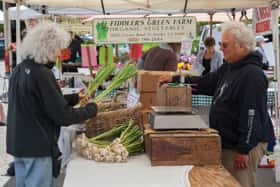 On paper, 2014’s Measure B seemed like the quintessential Marin political query. Marinites love all things organic and free-trade. And since tax dollars were not part of the equation, aside from the $1 million the county has agreed to spend to prepare the land for the project, Measure B seemed destined to collect a big W.
On paper, 2014’s Measure B seemed like the quintessential Marin political query. Marinites love all things organic and free-trade. And since tax dollars were not part of the equation, aside from the $1 million the county has agreed to spend to prepare the land for the project, Measure B seemed destined to collect a big W.
when a whole 18 percent of Marin voted “no.” Apparently, there’s an element out there who don’t fully appreciate the ability to know your farmer.
When you win with 82 percent of the vote, you generally charge into the populace, fist bumping with the Pope, inventing dances, and getting tattoos that read, “That’s right—82 percent!”
Nobody gets 82 percent.
That was November 2014. And as of this writing, AIM is still waiting on a memorandum of understanding with the County of Marin for the new project’s land lease. There is a rumor the MOU may come up for action in [May].
Bear in mind, the farmers market has only been a tenant with the county 34 years and chasing down credit references can be tricky.
But without a lease in hand, there’s no point in AIM sweet talking donors for cash. And so the massive momentum it won in 2014 evaporated like food samples at Costco on a Saturday.
No date has been given for a groundbreaking, as the project’s design still needs county approval, but since the county was included in the planning process, the project could gain it in less-than glacial fashion.
Designs for the future
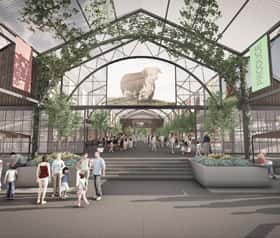 Since AIM is a nonprofit, its path to capital for the project is a bit different than an average retail business. Venture funding won’t do because the farmers market is a mature business. Investment banks are not the answer because the farmers market isn’t a candidate to go public in an IPO (Initial Public Offering). Private equity isn’t an option because of the nonprofit structure. But that same structure is a plus because AIM can solicit donations. It plans on raising a total of $20 million via a combination of grants and fundraising of donations. The balance of $4 million would be obtained through traditional debt financing.
Since AIM is a nonprofit, its path to capital for the project is a bit different than an average retail business. Venture funding won’t do because the farmers market is a mature business. Investment banks are not the answer because the farmers market isn’t a candidate to go public in an IPO (Initial Public Offering). Private equity isn’t an option because of the nonprofit structure. But that same structure is a plus because AIM can solicit donations. It plans on raising a total of $20 million via a combination of grants and fundraising of donations. The balance of $4 million would be obtained through traditional debt financing.
The possible cash breakdown would be $4 million from foundation and general grants and $16 million more from community-oriented contributions. Though AIM may not be looking to its board to write hefty checks, three board members ponied up $10,000 each to join the Founders Circle, a contributors group where AIM is targeting donors who can give between $10,000 to $100,000. The Visionary Circle has been created to target donations of $100,000.
In November, AIM received a donation of $1 million.
Initial costs will run about $6 million, which includes its business plan development, architectural designs and engineering, site development as well as construction of the parking lot and the Market Canopies that will shelter the vendors. The project is now being phased into two parts, with the Canopies being built first.
The non-profit plans on stretching its construction cash by obtaining discounts as a part of a philanthropic effort. It signed a memorandum of understanding in 2014 with the Marin Builders Association calling for the two groups to work in tandem on the project and for members of the MBA to make in-kind donations in the construction of the project.
The lion’s share of the money AIM hopes to raise ($19 million) will go to paying for the construction of the trio of buildings, a play area, greenhouses, a conference center, kitchen facilities and an arbor tying the SMART train stop to the Market Hall.
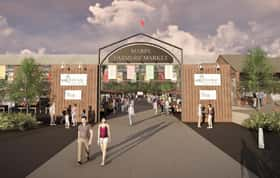 One way AIM hopes to raise money is by selling off the naming rights to a series of areas within the complex. For instance, should a business or brand or patron wish to have Canopy #1 named for them, all they need do is pony up $3 million. In comparison, Canopy’s #2 and #3 are bargains at just $1 million. All three Halls are on the block, going off at $2 million each. In total there are $15.5 million in naming rights for sale, with the most economical being the trio of stages at just $100K a piece.
One way AIM hopes to raise money is by selling off the naming rights to a series of areas within the complex. For instance, should a business or brand or patron wish to have Canopy #1 named for them, all they need do is pony up $3 million. In comparison, Canopy’s #2 and #3 are bargains at just $1 million. All three Halls are on the block, going off at $2 million each. In total there are $15.5 million in naming rights for sale, with the most economical being the trio of stages at just $100K a piece.
Not everybody can write those checks, and the first rule of business is to make it easy for shoppers or clients to pay you. So the AIM website now comes equipped with a button marked by a heart that says “Ways to give.” By pushing it, a screen emerges with donation amounts available ranging from $25-$1000, with options to add a monthly contribution.
The roots of AIM
The farmers’ market debuted in 1983 with Lynn Bagley at the helm. Bagley, the daughter of former assemblyman Bill Bagley, was no stranger to the political scene and negotiated with the Marin County Board of Supervisors to locate the new undertaking at the Civic Center. Over the years, Bagley and the members of the market grew the enterprise and it became more popular, earning coverage in the New York Times and going from a local’s hangout to a tourist destination as well.
But even as the market was gaining profile, tensions sprouted. Farmers chafed at the regulation coming down from market management, and management resented their pushback. Required annual meetings of the membership were neglected and factions within the association formed, pushing for a change in membership. Everybody wanted more security than what the county’s agreement was, which gave either side the ability to walk away from the location with 30-day’s notice. Eventually a lawsuit highlighting the gulf between the association and the management was filed and Bagley was forced out.
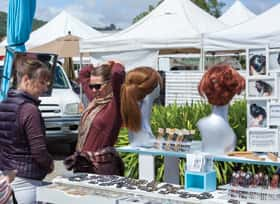 Brigette Moran, who cut her teeth in the North Bay creating events, was hired by the San Rafael Chamber of Commerce to produce a rival farmer’s market in downtown San Rafael, a move that was not welcomed by the Civic Center market. She was eventually hired as chief executive officer for the Civic Center markets and has been in charge ever since.
Brigette Moran, who cut her teeth in the North Bay creating events, was hired by the San Rafael Chamber of Commerce to produce a rival farmer’s market in downtown San Rafael, a move that was not welcomed by the Civic Center market. She was eventually hired as chief executive officer for the Civic Center markets and has been in charge ever since.
The idea of a permanent market has been around for years, but its expense kept it in the “Wouldn’t it be nice?” category. The reality is that since day one, the county or AIM could walk away from the markets with a 30-day notice, representing a thread-thin security for AIM and its members.
Moving the Thursday Market to Northgate because of construction is an example of how the 30-day notice works, and how flexible AIM has learned to be.
Econ reality
While Marin was on the cutting edge when the farmers market opened in 1983, the rest of the country has caught up, and that learning curve morphed into a double-edged sword. About three decades ago, there were 60 farmers markets selling fresh edibles in California. Today, that number tops 850. For anyone who has paid attention to the modern economy or knows folks in West Marin, the explosive growth in markets isn’t about agriculture expanding its footprint or a mighty growth of volume or variety of product bursting onto the scene. If anything, we now see fewer family farms nationally.
Farmers markets have become a popular, and in some cases, a beloved way to buy food. Consumers have helped fuel the rise of organics and farmers and ranchers have paid attention. An example is West Marin and the conversion of the majority of dairies from conventional to organic operations.
At the same time, eating organic has never been more popular with consumers. Whole Foods Markets out of Austin, Texas, helped create a mainstream demand and was considered an outlier in the supermarket sector. The grocery industry snickered at the notion that consumers cared about such things, and laughed harder at the idea they might pay a premium for those products. Meanwhile, “Whole Paycheck,” as Whole Foods became known, was laughing all the way to the bank.
Nothing catches the attention of retailers like the noise coming from somebody else’s cash register. National grocers and regional chains like Safeway and Raley’s have expanded their produce offerings and in-house organic labels.
That expansion did two things. It put pressure on Whole Foods as same store sales numbers tumbled with rivals getting into their pocket, and farmers have been presented with more opportunity to sell their goods.
With that increase as well as the bump in the number of farmer’s markets, farmers and ranchers have a wider variety of outlets, but they can spend too much time and money getting to the markets to sell, essentially spreading their business too thin.
The Market Hall presents a way for farmers and ranchers to have an everyday venue that doesn’t require putting up a booth and tearing it down hours later. It would give them an increased opportunity to build a following and strengthen their brand.
As for how the Market Hall goes forward, the new facility will be off the hook for the first three years from lease payments, presenting AIM with a chance to get the new facility fully leased and all the kinks worked out. Eventually, AIM will pay the county $150k a year in rent on a 40-year agreement with two, 10-year extensions possible. The agreement also includes annual rent adjustments of 2 percent and a rider that ensures the market will pay the county a percentage of gross revenues over prior year’s break even figure.
AIM reports its markets generate about $42.5 million in total revenues a year, with $15 million coming from the two Marin markets. AIM itself takes in about $2 million in revenues from rental fees and sales.
With the new facility in operation, farmers and businesses onsite could see an additional $14.7 million in added revenues per year. And the construction of the new facility would bring 169 hard hat jobs to the site. New jobs will also come from the new portions of the facility including the café, restaurant, butcher, dairy and seafood shops as well a bakery and the commercial kitchen. Tenants will be selected by Selection Task Force, which will include AIM leadership, local industry experts and leasing specialists.
The Market Hall would be open seven days per week for an average of 12 hours a day. The farmers markets on Sunday and Thursday will remain open from 8 a.m. to 1 p.m.
There is the possibility that AIM may add a third weekly market once the new facility is built and a track record has been established.
It’s ironic that a project that honors the tilling of soil and the harvesting of crops has not yet broken ground, but perhaps it is apropos, too. Growing anything in Marin is a challenge, which requires patience, skill, and in one form or another, a certain amount of manure.
Author
-

Bill Meagher is a contributing editor at NorthBay biz magazine. He is also a senior editor for The Deal, a Manhattan-based digital financial news outlet where he covers alternative investment, micro and smallcap equity finance, and the intersection of cannabis and institutional investment. He also does investigative reporting. He can be reached with news tips and legal threats at bmeagher@northbaybiz.com.
View all posts


